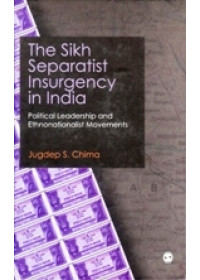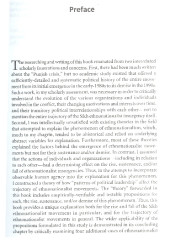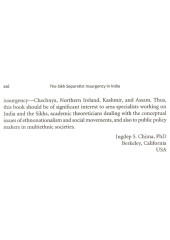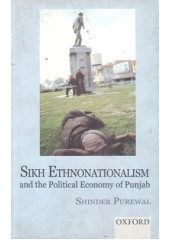Monday to Saturday - 10:00 Am to 9 PM
Now Enjoy Bulk Discounts on Books as Mentioned Below
These Discounts are in addition to the Discounts on Individual Books (Visible as Bulk Discount for Books in Cart)
Extra 10% Off If Books Purchased Exceeds Rs 3000 or 75 USD or 60 GBP or 60 Euro or 100 AUD or 100 CAD
Extra 15% Off If Books Purchased Exceeds Rs 6000 or 150 USD or 120 GBP or 120 Euro or 200 AUD or 200 CAD
Extra 20% Off If Books Purchased Exceeds Rs 15000 or 225 USD or 180 GBP or 180 Euro or 300 AUD or 300 CAD
Extra 25% Off If Books Purchased Exceeds Rs 30000 or 300 USD or 240 GBP or 240 Euro or 400 AUD or 400 CAD
Foreword To 'The Sikh Separatist Insurgency In India' By Jugdeep Singh Chima
Terrorist violence results essentially from ethnic, religious, and ideological motivations. Violence in Punjab, India in the later part of the 20th century took the form of an ethnonationalist movement for an independent Sikh state. Sikh content and context added the religious elements as a force multiplier, thereby increasing the scope and intensity of the violence.
Jugdep S. Chima is a third generation Sikh, who was born and raised in the Sikh diaspora in northern California. Punjabi and American cultures provided him with a passion for understanding and doing something about the human tragedy that encompassed his ancestral homeland. Jugdep began college in California as the movement and state carnage in Punjab increased yearly. He moved in a world of both Khalistan activists and supporters of the India state. Above all, he became involved in a scholarly context that increasingly led him to examine micro-political behavior on the one hand and theoretical constructs on the other.
His scholarly interests grew while examining the behavioral patterns of the Sikh insurgency and the larger arena of ethnonationalist and terrorist movements throughout the world. Focusing on a specific case helped inform him about particular patterns and provided avenues to understanding violent behavior in other situations. The reverse also is true with the comparative perspectives assisting him in understanding the "Punjab problem".
I witnessed these developments and Jugdep's continuing scholarly growth as his major advisor while he learned a PhD in political science. In one graduate seminar focusing on comparative terrorism, he compared and contrasted the Khalistan movement in Punjab with the "troubles" in Northern Ireland. A published article in a major peer-reviewed journal resulted. Scholarly intensity in research and publication marked his academic pursuits at the University of Missouri. Our intellectual exchanges were mutually beneficial.
Scholarly objectivity marks the author and the book that he now presents to the public. It doesn't well on "terror" as does so much of what has become a worldwide publishing industry. Political violence is a fact whether committed by a movement on the state. Categorizing a phenomenon as terrorist or as a movement by freedom fighters is a prejudgment. "Militant" became the acceptable term in Punjab for the armed Khalistani activists.
Jugdep's meticulous research-originally presented in a 1,000 page dissertation-involved the identification of leadership changes from point to point during the Khalistan insurgency and its battles with various state forces. His analysis establishes key points from the begninning to the end in what he terms the trajectory of the movement. Patterns of political leadership and the changes that took place are set forth as the key conceptual framework. His major contribution, therefore, is to the rich political and sociological literature on political elites.
The social sciences critically need a return to this type of focus if they are to deal with real life problems. In a test of his original theoretical formulations, Jugdep applies them to ethnonationalist movements in four others very different contexts. Chechny's first stage is an ethnic attempt at independence from Russia. It is reinforced in a second stage by Islamic redicalism. Thus, like Punjab, it involves ethnonationalism and religion. Northern Ireland and Kashmir also include both factors, ethnic and religious. Assam's case is more purely based on ethnic identities. In all these very dissimilar cultures, Jugdep's theoretical constructs provide a major comparative bridge.
Dr Jugdep Chima emerges with his present book as a significant contributor to comparative studies of political violence-read terrorism for the publishing industry-and provides notice that a young scholar is making his mark in the social sciences.
Preface To 'The Sikh Separatist Insurgency In India' By Jugdeep Singh Chima
The researching and writing on this book emanated form two interrelated scholarly frustrations and concerns. First, there had been much written about the "Punjab crisis," but no academic study existed that offered a sufficiently-detailed and systematic political history of the entire movement from its initial emergence in the early-1980s to its demise in the 1990s. Such a work, in my scholarly assessment, was necessary in order to critically understand the evolution of the various organizations and individuals involved in the conflict, their changing motivations and interests over time, and their transitory political interrelationships with each other-not to mention the entire trajectory of the Sikh ethnonationalist insurgency itself. Second, I was intellectually unsatisfied with existing theories in the field that attempted to explain the phenomenon of ethnonationalism, which much to my chagrin, tended to be ahistorical and relied on underlying abstract variables for explanation. Furthermore, most of these theories explained the factors behind the emergence of ethnonationalist movements but not for their sustenance and demise. In contrast, I assumed that the action of individuals and organizations-including in relation to each other-had a determining effect on the rise, sustenance, and fall of ethnonationalist insurgencies. Thus, in the attempt to incorporate observable human agency into the explanation for thiis phenomenon, I constructed a theory of how " patterns of political leadership" affect the trajectory of ethnonationalist movements. The "theory" forwarded in this book includes empirically and testable propositions for each, the rise, sustenance, demise of this phenomenon. Thus, this book provides a unique explanation both for the rise and fall of the Sikh ethnonationalist movement in particular, and for the trajectory of ethnonationalist movements in general. The wider applicability of the propositions formulated in this study is demonstrated in its concluding chapter by critically examining four additional cases of ethnonationalist insurgency-Chechnya, Northern Ireland, Kashmir, and Assam. Thus, this book should be of significant interest to area specialists working on India and the Sikhs, academic theoriticians dealing with the conceptual issues of ethnonationalism and social movements, and also to public policy makers in multiethnic societies.
Table Of Contents For 'The Sikh Separatist Insurgency In India' By Jugdeep Singh Chima
| List of Tables | ix | |
| List of Abbreviations | xi | |
| Foreword by Dr Paul Wallace | xiii | |
| Preface | xv | |
| Acknowledgements | xvii | |
|
PART I: Introduction |
||
| 1 | "Patterns of political leadership" and Ethnonationalist Insurgency | 3 |
| 2 | Sikh Ethnic Identity and Early Post-Independence Politics in Punjab | 22 |
|
PART II: The Emergence of the Sikh Ethnonationalist Movement (1978-1984) |
||
| 3 | Begninnings of Sikh Extremism (1978-1981) | 41 |
| 4 | Emergence of Ethnonationalist Violence (1981-1983) | 58 |
| 5 | Agitation, Ethnic Insurgency, and the Road to Operation Bluestar (1983-1984) | 79 |
|
PART III: The Sustenance of the Sikh Ethnonationalist Movement (1984-1992) |
||
| 6 | Failed Political Compromises and Re-marginalization of Sikh Moderates (1984-1986) | 103 |
| 7 | Reorganization of the Militants and the Armed Struggle for Khalistan (1986-1988) | 127 |
| 8 | The Divided State and Electoral Victory of the Extremists (1988-1990) | 157 |
| 9 | Escalating Factionalism and Internecine Violence within the Separatist Movement (1990-1992) | 182 |
|
PART IV: The Demise of the Sikh Ethnonationalist Movement (1992-1997) |
||
| 10 | Crushing of the Violent Sikh Ethnonatiionalist Movement by the Unified State (1992-1993) | 217 |
| 11 | Return of Normalcy to Punjab and Sikh Politics (1993-1997) | 238 |
|
PART V: Conclusion |
||
| 12 | "Patterns of Political Leadership" and Ethnonationalist Insurgency in a Comparative Perspective | 263 |
| Glossary | 297 | |
| Select Bibliography | 300 | |
| Index | 307 | |
| About the Author | 315 |
| Books | |
| Author | Jagdeep Singh Chhima |
| Pages | 314 |
| Cover | Hardbound |
| Language | English |
The Sikh Separatist Insurgency In India - Book By Jugdeep Singh Chima
- Brand: Sage Publication
- Product Code: SHE146
- Availability: In Stock
-
Rs.795.00
Related Products
The Punjab Story - Reissued On The 20th Anniversary Of Operation Bluestar - Book By Khushwant Singh
Table Of Contents For 'The Punjab Story - Reissued On The 20th Anniversary Of Operation Bluesta..
Rs.295.00
1984 Lessons from History - Intrigue and Conflict in Centre - Sikh Relations - Books by Harminder Kaur
Table of Contents For '1984 Lessons from History - Intrigue and Conflict in Centre - Sikh Relatio..
Rs.595.00
Sikh Ethnonationalism And The Political Economy Of Punjab - Book By Shinder Purewal
Introduction To 'Sikh Ethnonationalism And The Political Economy Of Punjab' By Shinder Purewal ..
Rs.545.00
Tags: the sikh separatist insurgency i india, book, jugdeep, singh, chima, history, and, punjab, books, english









